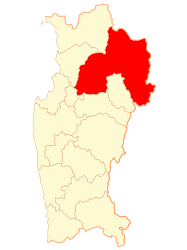Vicuña (Chile)
| Vicuña | ||
|---|---|---|
|
|
||
| Coordinates | 30 ° 2 ′ S , 70 ° 43 ′ W | |

|
||
| Symbols | ||
|
||
| Basic data | ||
| Country | Chile | |
| Coquimbo | ||
| ISO 3166-2 | CL-CO | |
| province | Elqui | |
| height | 620 m | |
| surface | 7,609.8 km² | |
| Residents | 24,010 (2002) | |
| density | 3.2 Ew. / km² | |
| Website | www.munivicuna.cl (Spanish) | |
| politics | ||
| mayor | Fernando Guamán Guamán | |
| Political party | independent | |
|
Torre Bauer in the center of Vicuña
|
||
Vicuña is a city in the Región de Coquimbo in northern Chile and is located 54 kilometers east of La Serena inland. The city had 24,010 inhabitants in 2002, of whom 12,910 lived in the city itself and 11,100 in the surrounding area. With an area of 7,609.8 km², Vicuña is the largest city in the Coquimbo region.
The city was founded in 1821 during the reign of Joaquín Vicuña on the instructions of Bernardo O'Higgins to ensure sovereignty in the Río Elqui area. It was first called San Isidro de Vicuña and renamed Vicuña in 1872.
geography
Vicuña is located about 54 kilometers east of the coastal town of La Serena in the mountainous interior. The city is located on the Elqui River at an altitude of 620 m . The Río Elqui is dammed at the Puclaro dam ( Embalse Puclaro ) about ten kilometers west of the city . While irrigated agriculture is possible in the valley, only low bushes thrive on the very dry mountains north and south of the city.
The city is connected to the country's road network by National Road 41 ( Ruta CH-41 ), which leads to La Serena.
Attractions
The landmark of the city is the Torre Bauer in the center of Vicuña, which today houses the tourist information. The tower was built under Mayor Adolfo Bauer, who gave the tower its name, and was completed in 1905.
Due to the mostly very clear days and nights, there are several astronomical observatories near Vicuña. About 17 kilometers southwest of Vicuña's city center is Cerro Tololo, over 2,200 meters high, on which the Cerro Tololo Inter-American Observatory is located. It is equipped with several astronomical telescopes and instruments. In contrast to the Cerro Tololo Observatory, which can only be visited by day tourists and which can only be used by astronomers, the Mamalluca Observatory is also open to the public about 10 kilometers north of Vicuña.
Another ten kilometers south of the Cerro Tololo Observatory are the international Gemini South observatory and the SOAR Telescope on the 2,700 meter high Cerro Pachón . A good kilometer west of the Gemini Observatory, the Large Synoptic Survey Telescope is under construction and is scheduled for completion in 2019 to 2022.
population
The city of Vicuña had a total of 24,010 inhabitants in the 2002 census, of which 12,910 lived in the city itself and 11,100 in the surrounding area. 12,302 inhabitants were men and 11,708 women. Due to the large area of 7,609.8 km², most of which are uninhabited, Vicuña has a population density of only 3.2 people per square kilometer.
Daughter of the city
In the city center there is a square dedicated to the most famous inhabitant of Gabriela Mistral . The poet was born here in 1889 and won the Nobel Prize for Literature in 1945 . Today in Vicuña there is also a museum about the life and works of the poet.
economy
Vicuña is a main production center for the Chilean national drink pisco . The largest pisco producer in Chile, the Cooperativa Agrícola Pisquera Elqui Limitada ( CAPEL ), is based in this region.
Web links
Individual evidence
- ↑ a b National Statistics Institute of Chile: Censo 2002 (Spanish)
- ↑ Presentation on the history of Vicuñas (PDF; 7.3 MB), page 3 (Spanish)



